Compaction of chromatin by diverse Polycomb group proteins requires localized regions of high charge
- PMID: 22012622
- PMCID: PMC3205590
- DOI: 10.1101/gad.17288211
Compaction of chromatin by diverse Polycomb group proteins requires localized regions of high charge
Abstract
Polycomb group (PcG) proteins are required for the epigenetic maintenance of developmental genes in a silent state. Proteins in the Polycomb-repressive complex 1 (PRC1) class of the PcG are conserved from flies to humans and inhibit transcription. One hypothesis for PRC1 mechanism is that it compacts chromatin, based in part on electron microscopy experiments demonstrating that Drosophila PRC1 compacts nucleosomal arrays. We show that this function is conserved between Drosophila and mouse PRC1 complexes and requires a region with an overrepresentation of basic amino acids. While the active region is found in the Posterior Sex Combs (PSC) subunit in Drosophila, it is unexpectedly found in a different PRC1 subunit, a Polycomb homolog called M33, in mice. We provide experimental support for the general importance of a charged region by predicting the compacting capability of PcG proteins from species other than Drosophila and mice and by testing several of these proteins using solution assays and microscopy. We infer that the ability of PcG proteins to compact chromatin in vitro can be predicted by the presence of domains of high positive charge and that PRC1 components from a variety of species conserve this highly charged region. This supports the hypothesis that compaction is a key aspect of PcG function.
Figures

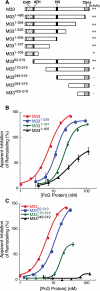
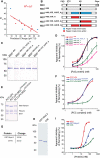
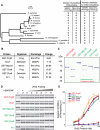

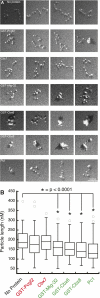
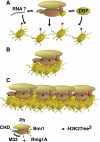
Similar articles
-
Functional dissection of Polycomb repressive complex 1 reveals the importance of a charged domain.Cold Spring Harb Symp Quant Biol. 2010;75:61-70. doi: 10.1101/sqb.2010.75.056. Epub 2011 Apr 18. Cold Spring Harb Symp Quant Biol. 2010. PMID: 21502414
-
A core subunit of Polycomb repressive complex 1 is broadly conserved in function but not primary sequence.Proc Natl Acad Sci U S A. 2012 May 1;109(18):E1063-71. doi: 10.1073/pnas.1118678109. Epub 2012 Apr 18. Proc Natl Acad Sci U S A. 2012. PMID: 22517748 Free PMC article.
-
Stabilization of chromatin structure by PRC1, a Polycomb complex.Cell. 1999 Jul 9;98(1):37-46. doi: 10.1016/S0092-8674(00)80604-2. Cell. 1999. PMID: 10412979
-
Molecular architecture of polycomb repressive complexes.Biochem Soc Trans. 2017 Feb 8;45(1):193-205. doi: 10.1042/BST20160173. Biochem Soc Trans. 2017. PMID: 28202673 Free PMC article. Review.
-
[Polycomb group protein complexes].Yi Chuan. 2009 Oct;31(10):977-81. doi: 10.3724/sp.j.1005.2009.00977. Yi Chuan. 2009. PMID: 19840918 Review. Chinese.
Cited by
-
PRC1-independent binding and activity of RYBP on the KSHV genome during de novo infection.PLoS Pathog. 2022 Aug 26;18(8):e1010801. doi: 10.1371/journal.ppat.1010801. eCollection 2022 Aug. PLoS Pathog. 2022. PMID: 36026503 Free PMC article.
-
Live-cell single-molecule tracking reveals co-recognition of H3K27me3 and DNA targets polycomb Cbx7-PRC1 to chromatin.Elife. 2016 Oct 10;5:e17667. doi: 10.7554/eLife.17667. Elife. 2016. PMID: 27723458 Free PMC article.
-
Synergy between Variant PRC1 Complexes Defines Polycomb-Mediated Gene Repression.Mol Cell. 2019 Jun 6;74(5):1020-1036.e8. doi: 10.1016/j.molcel.2019.03.024. Epub 2019 Apr 24. Mol Cell. 2019. PMID: 31029541 Free PMC article.
-
Distinct Cellular Assembly Stoichiometry of Polycomb Complexes on Chromatin Revealed by Single-molecule Chromatin Immunoprecipitation Imaging.J Biol Chem. 2015 Nov 20;290(47):28038-28054. doi: 10.1074/jbc.M115.671115. Epub 2015 Sep 17. J Biol Chem. 2015. PMID: 26381410 Free PMC article.
-
Phase separation by the polyhomeotic sterile alpha motif compartmentalizes Polycomb Group proteins and enhances their activity.Nat Commun. 2020 Nov 5;11(1):5609. doi: 10.1038/s41467-020-19435-z. Nat Commun. 2020. PMID: 33154383 Free PMC article.
References
-
- Agianian B, Leonard K, Bonte E, Van der Zandt H, Becker PB, Tucker PA 1999. The glutamine-rich domain of the Drosophila GAGA factor is necessary for amyloid fibre formation in vitro, but not for chromatin remodelling. J Mol Biol 285: 527–544 - PubMed
-
- Alkema MJ, Bronk M, Verhoeven E, Otte A, van 't Veer LJ, Berns A, van Lohuizen M 1997. Identification of Bmi1-interacting proteins as constituents of a multimeric mammalian polycomb complex. Genes Dev 11: 226–240 - PubMed
-
- Boyer LA, Plath K, Zeitlinger J, Brambrink T, Medeiros LA, Lee TI, Levine SS, Wernig M, Tajonar A, Ray MK, et al. 2006. Polycomb complexes repress developmental regulators in murine embryonic stem cells. Nature 441: 349–353 - PubMed
Publication types
MeSH terms
Substances
Grants and funding
LinkOut - more resources
Full Text Sources
Molecular Biology Databases
Research Materials
